ML Aggarwal Triangles Exe-10.3 for ICSE Class 9 Maths Solutions Ch-10. Step by Step Answer of Exe-10.3 of Triangles of ML Aggarwal for ICSE Class 9th Mathematics Questions. Visit official website CISCE for detail information about ICSE Board Class-9.
ML Aggarwal Triangles Exe-10.3 for ICSE Class 9 Maths Solutions Ch-10
| Board | ICSE |
| Subject | Maths |
| Class | 9th |
| Chapter-10 | Triangles |
| Topics | Solution of Exe-10.3 Questions |
| Academic Session | 2024-2025 |
Solution of Exe-10.3 Questions
ML Aggarwal Triangles Exe-10.3 for ICSE Class 9 Maths Solutions Ch-10
Question 1. ABC is a right angled triangle in which ∠A = 90° and AB = AC. Find ∠B and ∠C.
Answer : In right angled triangle ABC, ∠A = 90o
∠B + ∠C
= 180o – ∠A
= 180o – 90o = 90o

Because AB = AC
∠C = ∠B (Angles opposite to equal sides)
∠B + ∠B = 90o
(2∠B = 90o)
⇒ ∠B = 90/2o = 45o
⇒ ∠B = ∠C = 45o
⇒ ∠B = ∠C = 45o
Question 2. Show that the angles of an equilateral triangle are 60° each.
Answer : ∆ABC is an equilateral triangle
AB = BC = CA
∠A = ∠B = ∠C (opposite to equal sides )
But ∠A + ∠B + ∠C = 180o (sum of angles of a triangle)
3∠A = 180o (∠A = 180o/3 = 60o)
⇒ ∠A = ∠B = ∠C = 60o
Question 3. Show that every equiangular triangle is equilateral.
Answer : ∆ABC is an equiangular

∠A = ∠B = ∠C
In ∆ABC
∠B = ∠C …(i)
AC = AB …(ii) (sides opposite to equal angles)
∠C = ∠A
BC = AB
From (i) and (ii)
AB = BC = AC
∆ABC is an equilateral triangle
Question 4. In the following diagrams, find the value of x:
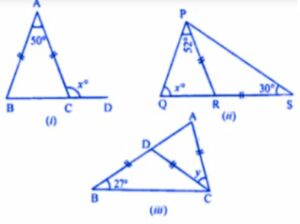
Answer : (i) In following diagram given that AB =AC
That is ∠B = ∠ ACB (angles opposite to equal sides in a triangle are equal)
In a triangle are equal)
Now, ∠A + ∠B + ∠ACB = 180o (sum of all angles in a triangle is 180o)
50 + ∠B + ∠B = 180o(∠A = 50o (given) ∠B = ∠ACB)
⇒ 50o + 2 ∠B = 180o (2∠B = 180o – 50o)
⇒ 2∠B = 130o (∠B = 130/2 = 65o)
⇒ ∠ACB = 65o
Also ∠ACB + xo = 180o (Linear pair)
⇒ 65o + xo = 180o (xo = 180o – 65o)
⇒ xo = 115o
Hence, Value of x = 115
(ii) in ∆PRS,
Given that PR = RS
∠PSR = ∠RPS (Angles opposite in a triangle, equal sides are equal)
30o = ∠RPS …(i) (∠PPS = 30o)
⇒ ∠QPS = ∠QPR + ∠RPS
⇒ ∠QPS = 52o + 30o (Given, ∠QPR = 52o and from (i), ∠RPS = 30o)
⇒ ∠QPS = 82o
Now, In ∆PQS
∠QPS + ∠QSP + PQS = 180o (sum of all angles in a triangles is 180o)
= 82o + 30o + xo = 180o (from (2) ∠QPS = 82o and ∠QSP = 30o (given)
⇒ 112o + xo = 180o (xo = 180o – 112o)
Hence, Value of x = 68
(iii) In the following figure, Given
That, BD = CD = AC and ∠DBC = 27o
Now in ∆BCD,
BD = CD (Given)
⇒ ∠DBC = ∠BCD …(1) (in a triangle sides opposite equal angles are equal)
Also,, ∠DBC = 27o ….(2) (given)
From (1) and (2) we get
∠BCD = 27o
Now,
∠CDA = ∠DBC + ∠BCD (exterior angles is equal to sum of two interior opposite angles)
Ext ∠CDA = 27o + 27o [from (2) and (3)]
∠CDA = 54o
Also, in ∆ACD
∠CAD + ∠CDA + ∠ACD = 180o (sum of all angles in a triangle is 180o)
⇒ 54o + 54o+ Y = 180o
⇒ 108o + Y = 180o (Y = 180o – 108o)
⇒ y = 72o
Question 5. In the following diagrams, find the value of x:
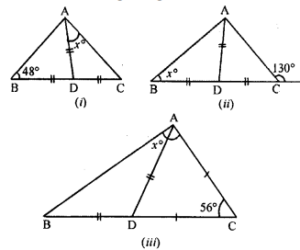
Answer :
Question 6.
(a) In the figure (1) given below, AB = AD, BC = DC. Find ∠ ABC.
(b)In the figure (2) given below, BC = CD. Find ∠ACB.
(c) In the figure (3) given below, AB || CD and CA = CE. If ∠ACE = 74° and ∠BAE =15°, find the values of x and y.
Answer : Update soon..
Question 7. In ∆ABC, AB = AC, ∠A = (5x + 20)° and each of the base angle is  the of ∠A. Find the measure of ∠A.
the of ∠A. Find the measure of ∠A.
Answer :
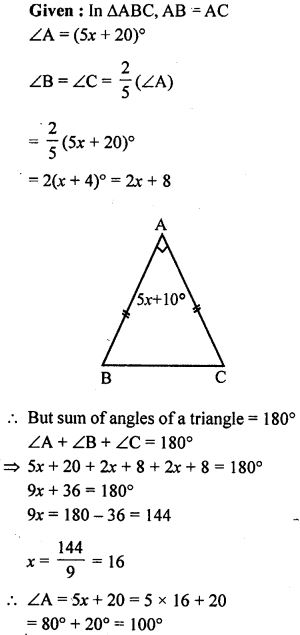
Question 8. (a) In the figure (1) given below, ABC is an equilateral triangle. Base BC is produced to E, such that BC’= CE. Calculate ∠ACE and ∠AEC.
(b) In the figure (2) given below, prove that ∠ BAD : ∠ ADB = 3 : 1.
(c) In the figure (3) given below, AB || CD. Find the values of x, y and ∠.

Answer : (a) in following figure
Given,
ABC is an equilateral triangle BC = CE
To find: ∠ACE and ∠AEC
As given that ABC is an equilateral triangle,
That is ∠BAC = ∠B = ∠ACB = 60o …(1) (each angle of an equilateral triangle is 60o)
Now, ∠ACE = ∠BAC + CB (Exterior angle is equal to sum of two interior opposite angles) (∠ACE = 60o + 60o)
∠ACE = 1200
Then, in ∆ACE
Given, AC = CE [because AC = BC = CE]
∠CAE = ∠AEC …(2)
We know that, in a triangle equal sides have equal angles opposite to them.
So, ∠CAE + ∠AEC + 120o = 80o
⇒ ∠AEC + ∠AEC + 120o = 180o [by equation (2) we get]
⇒ 2∠AEC = 180o – 120o
⇒ 2∠AEC = 60o
⇒ ∠AEC = 60o/2
⇒ ∠AEC = 30o
Therefore, ∠ACE = 120o and ∠AEC = 30o.
(b) In given figure,
Given, ∆ABD, AC meets BD in C. AB = BC, AC = CD.
We have to prove that, ∠BAD : ∠ADB = 3: 1
Then, consider ∆ABC,
AB = BC [given]
Therefore, ∠ACB = ∠BAC …(1) (In a triangle, equal angles opposite to them)
In ∆ACD,
AC = CD [given]
Therefore, ∠ADC = ∠CAD (In a triangle, equal sides have equal angles opposite to them)
∠CAD = ∠ADC …(2)
From, adding (1) and (2), we get
∠BAC + ∠CAD = ∠ACB + ∠ADC
⇒ ∠BAD = ∠ACB + ∠ADC …(3)
Now, in ∆ACD
Exterior ∠ACB = ∠CAD + ∠ADC …(4) (In an triangle, exterior angle is equal to sum of two interior opposite angles)
Therefore, ∠ACB = ∠ADC + ∠ADC [from (2) and (4)]
∠ACB = 2∠ADC …(5)
Now, ∠BAD = 2∠ADC + ∠ADC [from (3) and (4)]
⇒ ∠BAD = 3∠ADC = (∠BAD/∠ADC) = 3/1
⇒ ∠BAD: ∠ADC = 3: 1
(c) In given figure,
Given, AB parallel to CD, ∠ECD = 24o, ∠CDE = 42o
We have to find the value of x, y and z.
Consider, ∆CDE
Exterior, ∠CEA = 24o + 42o (In a triangle exterior angle is equal to sum of two interior opposite angles)
∠CEA = 66o …(1)
Then, in ∆ACE
AC = CE (given)
Therefore, ∠CAE = ∠CEA (In a triangle equal side have equal angles opposite to them)
By equation (1),
Y = 66o …(2)
Also, y + z + ∠CEA = 180o
We know that, sum of all angles in a triangle is 180o
66o + z + 66o = 180o
⇒ z + 132o = 180o
⇒ z = 180o – 132o
⇒ z = 48o …(3)
Then it is given that, AB is parallel to CD,
∠x = ∠ADC [alternate angles]
⇒ x = 42o …(4)
Hence, from (2), (3) and (4) equation gives x = 42o, y = 66o and z = 48o.
Question 9. In the given figure, D is mid-point of BC, DE and DF are perpendiculars to AB and AC respectively such that DE = DF. Prove that ABC is an isosceles triangle.
Answer : D is the midpoint of BC
DE perpendicular to AB
And DF perpendicular to AC
DE = DE
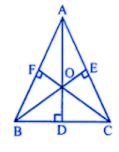
To prove:
Triangle ABC is an isosceles triangle
Proof:
In the right angled triangle BED and CDF
Hypotenuse BD = DC (because D is a midpoint)
Side DF = DE (given)
∆BED ≅ ∆CDF (RHS axiom)
∠C = ∠B
AB = AC (sides opposite to equal angles)
∆ABC is an isosceles triangle
Question 10. In the given figure, AD, BE and CF arc altitudes of ∆ABC. If AD = BE = CF, prove that ABC is an equilateral triangle.
Answer : AD, BE and CF are altitudes of ∆ABC and
AD = BE = CF

To prove : ∆ABC is an equilateral triangle
Proof: in the right ∆BEC and ∆BFC
Hypotenuse BC = BC (Common)
Side BE = CF (Given)
∆BEC ≅ ∆BFC (RHS axiom)
∠C = ∠B
AB = AC (sides opposite to equal angles)
Similarly we can prove that ∆CFA ≅ ∆ADC
∠A = ∠C
AB = BC
From (i) and (ii)
AB = BC = AC
∆ABC is an equilateral triangle
Question 11. In a triangle ABC, AB = AC, D and E are points on the sides AB and AC respectively such that BD = CE. Show that:
(i) ∆DBC ≅ ∆ECB
(ii) ∠DCB = ∠EBC
(iii) OB = OC, where O is the point of intersection of BE and CD.
Answer:

Question 12. ABC is an isosceles triangle in which AB = AC. P is any point in the interior of ∆ABC such that ∠ABP = ∠ACP. Prove that
(a) BP = CP
(b) AP bisects ∠BAC.
Answer : (a)
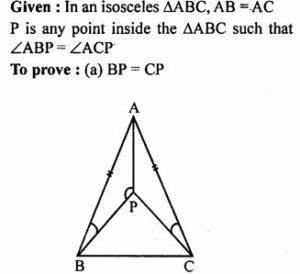
Proof:
In tr. APB and tr. APC,
AB = AC [given]
∠ ABP = ∠ ACP [given]
AP = AP [common]
So Tr ABP and Tr ACP are congruent by (SSA)
So BP = PC c.p.c.t.
(b) To Prove: AP bisects angle BAC
angle PAB = angle PAC [corresponding angles of congruent triangles]
thus, AP bisects angle BAC.
hence proved.
Question 13. In the adjoining figure, D and E are points on the side BC of ∆ABC such that BD = EC and AD = AE. Show that ∆ABD ≅ ∆ACE.
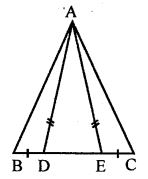
Answer :
Point D and E are on side BC of ∆ABC,
such that BD = CE ,and AD = AE .
To prove : ∆ABD congruent to ∆ACE
proof :
(i) In ∆ADE ,
AD = AE ( given )
∠ADE = ∠AED = x
[ Angles opposite to equal sides ]
ii ) ∠ADB + ∠ADC= 180°
[ Linear pair ]
∠ADB + x = 180°
∠ADB = 180° – x —–( 1 )
(iii) Similarly ,
∠AEC = 180° – x ——–( 2 )
(iv) In ∆ABD and ∆ACE ,
BD = EC ( S ) given ,
∠ADE = ∠AEC ( A ) from ( 1 ) and ( 2 )]
AD = AE ( S ) given ,
Hence ,
∆ABD is congruent to ∆ACE.
[ ASA congruence Rule ]
Question 14.
(a) In the figure (i) given below, CDE is an equilateral triangle formed on a side CD of a square ABCD. Show that ∆ADE ≅ ∆BCE and hence, AEB is an isosceles triangle.

(b) In the figure (ii) given below, O is a point in the interior of a square ABCD such that OAB is an equilateral triangle. Show that OCD is an isosceles triangle.
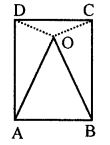
Answer:-
Question 15. In the given figure, ABC is a right triangle with AB = AC. Bisector of ∠A meets BC at D. Prove that BC = 2AD.
Answer :

In ∆ABD and ∆ACD
AB = AC (given)
∠BAD = ∠CAD
As AD is bisector of ∠A and AD = AD
⇒ ∆DAB = ∆DAC (by SAS congruency rule)
⇒ ∠ADB = ∠ADC (by c.p.c.t)
⇒ ∠ADB = ∠ADC = 90°
and BD = DC
In ∆ABD,
AD2 + BD2 = AB2 …(i)
⇒ AD2 + DC2 = AC2 …(ii)
Adding (i) and (ii), we get
2 AD2 + BD2 + DC2 = AB2 + AC2
⇒ 2AD2 + BD2 + DC2 = BC2
⇒ 2 AD2 + 2BD2 = BC2
⇒ 2 (AD2 + BD2) = BC2

⇒ 4 AD2 = BC2
⇒ 2 AD = BC
i.e. BC = 2AD
Hence proved.
— : End of ML Aggarwal Triangles Exe-10.3 for ICSE Class 9 Maths Solutions Ch-10 :–
Return to :- ML Aggarawal Maths Solutions for ICSE Class-9
Thanks
Please Share with Your Friends
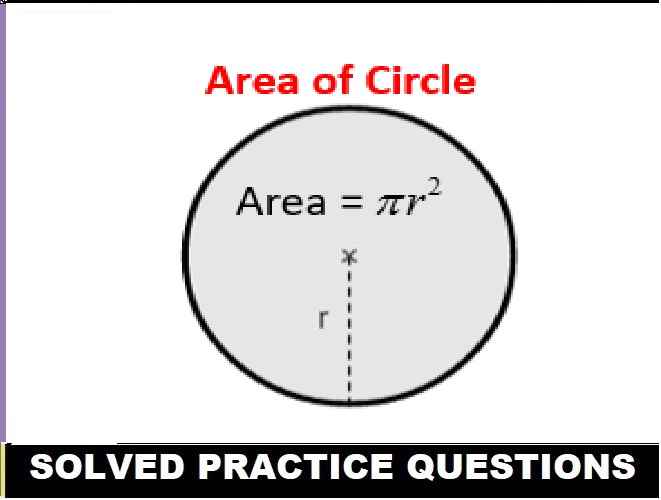

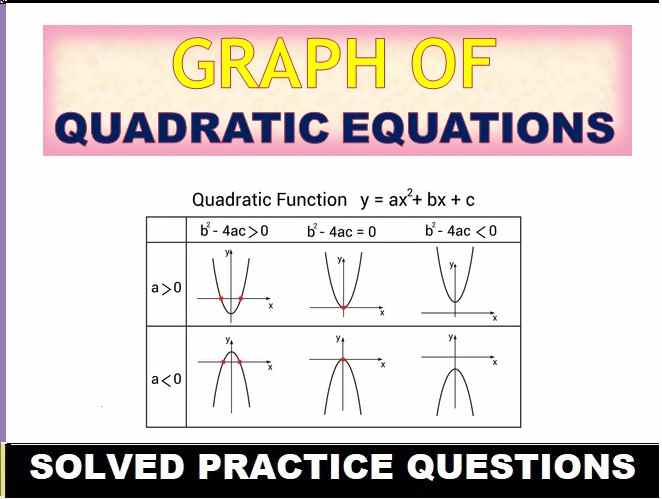
In 10.3 question 12 is wrong answer is given we cannot prove by SAS bcz adjacent side is not given equal .hope u correct it
updated now